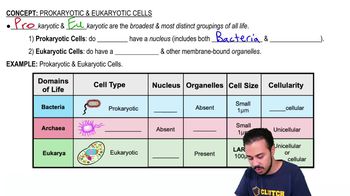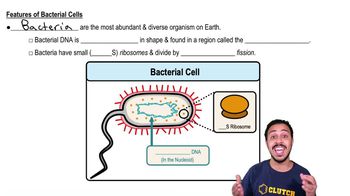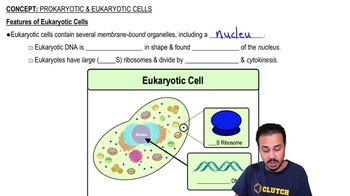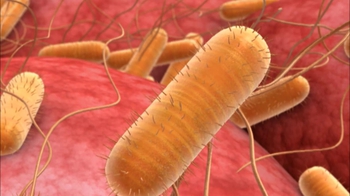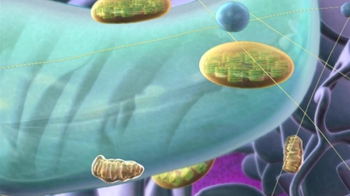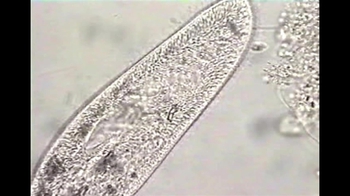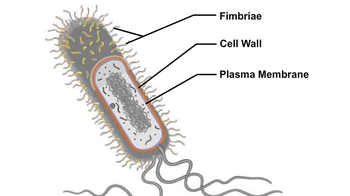Table of contents
- 1. Introduction to Biology2h 42m
- 2. Chemistry3h 40m
- 3. Water1h 26m
- 4. Biomolecules2h 23m
- 5. Cell Components2h 26m
- 6. The Membrane2h 31m
- 7. Energy and Metabolism2h 0m
- 8. Respiration2h 40m
- 9. Photosynthesis2h 49m
- 10. Cell Signaling59m
- 11. Cell Division2h 47m
- 12. Meiosis2h 0m
- 13. Mendelian Genetics4h 44m
- Introduction to Mendel's Experiments7m
- Genotype vs. Phenotype17m
- Punnett Squares13m
- Mendel's Experiments26m
- Mendel's Laws18m
- Monohybrid Crosses19m
- Test Crosses14m
- Dihybrid Crosses20m
- Punnett Square Probability26m
- Incomplete Dominance vs. Codominance20m
- Epistasis7m
- Non-Mendelian Genetics12m
- Pedigrees6m
- Autosomal Inheritance21m
- Sex-Linked Inheritance43m
- X-Inactivation9m
- 14. DNA Synthesis2h 27m
- 15. Gene Expression3h 20m
- 16. Regulation of Expression3h 31m
- Introduction to Regulation of Gene Expression13m
- Prokaryotic Gene Regulation via Operons27m
- The Lac Operon21m
- Glucose's Impact on Lac Operon25m
- The Trp Operon20m
- Review of the Lac Operon & Trp Operon11m
- Introduction to Eukaryotic Gene Regulation9m
- Eukaryotic Chromatin Modifications16m
- Eukaryotic Transcriptional Control22m
- Eukaryotic Post-Transcriptional Regulation28m
- Eukaryotic Post-Translational Regulation13m
- 17. Viruses37m
- 18. Biotechnology2h 58m
- 19. Genomics17m
- 20. Development1h 5m
- 21. Evolution3h 1m
- 22. Evolution of Populations3h 52m
- 23. Speciation1h 37m
- 24. History of Life on Earth2h 6m
- 25. Phylogeny2h 31m
- 26. Prokaryotes4h 59m
- 27. Protists1h 12m
- 28. Plants1h 22m
- 29. Fungi36m
- 30. Overview of Animals34m
- 31. Invertebrates1h 2m
- 32. Vertebrates50m
- 33. Plant Anatomy1h 3m
- 34. Vascular Plant Transport1h 2m
- 35. Soil37m
- 36. Plant Reproduction47m
- 37. Plant Sensation and Response1h 9m
- 38. Animal Form and Function1h 19m
- 39. Digestive System1h 10m
- 40. Circulatory System1h 57m
- 41. Immune System1h 12m
- 42. Osmoregulation and Excretion50m
- 43. Endocrine System1h 4m
- 44. Animal Reproduction1h 2m
- 45. Nervous System1h 55m
- 46. Sensory Systems46m
- 47. Muscle Systems23m
- 48. Ecology3h 11m
- Introduction to Ecology20m
- Biogeography14m
- Earth's Climate Patterns50m
- Introduction to Terrestrial Biomes10m
- Terrestrial Biomes: Near Equator13m
- Terrestrial Biomes: Temperate Regions10m
- Terrestrial Biomes: Northern Regions15m
- Introduction to Aquatic Biomes27m
- Freshwater Aquatic Biomes14m
- Marine Aquatic Biomes13m
- 49. Animal Behavior28m
- 50. Population Ecology3h 41m
- Introduction to Population Ecology28m
- Population Sampling Methods23m
- Life History12m
- Population Demography17m
- Factors Limiting Population Growth14m
- Introduction to Population Growth Models22m
- Linear Population Growth6m
- Exponential Population Growth29m
- Logistic Population Growth32m
- r/K Selection10m
- The Human Population22m
- 51. Community Ecology2h 46m
- Introduction to Community Ecology2m
- Introduction to Community Interactions9m
- Community Interactions: Competition (-/-)38m
- Community Interactions: Exploitation (+/-)23m
- Community Interactions: Mutualism (+/+) & Commensalism (+/0)9m
- Community Structure35m
- Community Dynamics26m
- Geographic Impact on Communities21m
- 52. Ecosystems2h 36m
- 53. Conservation Biology24m
5. Cell Components
Prokaryotic & Eukaryotic Cells
Problem 10`
Textbook Question
Eukaryotic cells differ from prokaryotic cells in that only eukaryotic cells ________.
a. Contain DNA
b. Have a plasma membrane
c. Are considered to be alive
d. Have a nucleus
e. Are able to evolve
 Verified step by step guidance
Verified step by step guidance1
Step 1: Understand the key difference between eukaryotic and prokaryotic cells. Eukaryotic cells are characterized by having membrane-bound organelles, including a nucleus, while prokaryotic cells lack these structures.
Step 2: Analyze the options provided in the question. Option (a) 'contain DNA' is incorrect because both eukaryotic and prokaryotic cells contain DNA as their genetic material.
Step 3: Evaluate option (b) 'have a plasma membrane.' This is also incorrect because both eukaryotic and prokaryotic cells have a plasma membrane that encloses the cell and regulates the movement of substances in and out.
Step 4: Consider option (c) 'are considered to be alive.' This is incorrect because both eukaryotic and prokaryotic cells are considered living entities.
Step 5: Focus on option (d) 'have a nucleus.' This is the correct answer because only eukaryotic cells have a true nucleus, which is a membrane-bound structure that houses the cell's DNA. Option (e) 'are able to evolve' is incorrect because both types of cells are capable of evolution.
 Verified video answer for a similar problem:
Verified video answer for a similar problem:This video solution was recommended by our tutors as helpful for the problem above
Video duration:
41sPlay a video:
Was this helpful?
Key Concepts
Here are the essential concepts you must grasp in order to answer the question correctly.
Eukaryotic vs. Prokaryotic Cells
Eukaryotic cells are complex cells that contain a nucleus and membrane-bound organelles, while prokaryotic cells are simpler and lack a nucleus. This distinction is fundamental in biology, as it affects cellular processes, organization, and the overall functioning of organisms. Eukaryotes include animals, plants, fungi, and protists, whereas prokaryotes primarily consist of bacteria and archaea.
Recommended video:
Guided course
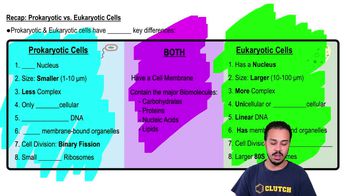
Recap: Prokaryotic vs. Eukaryotic Cells
Nucleus
The nucleus is a membrane-bound organelle found in eukaryotic cells that houses the cell's genetic material (DNA). It plays a crucial role in regulating gene expression and mediating the replication of DNA during the cell cycle. The presence of a nucleus is a defining feature that distinguishes eukaryotic cells from prokaryotic cells, which have their genetic material located in the cytoplasm.
Recommended video:
Guided course

Nucleus
Cellular Organization
Cellular organization refers to the structural arrangement of cells and their components. Eukaryotic cells exhibit a higher level of organization, with specialized organelles performing distinct functions, contributing to the cell's overall efficiency and complexity. This organization allows for greater cellular specialization and the development of multicellular organisms, which is not seen in prokaryotic cells.
Recommended video:
Guided course

Organization of DNA in the Cell

 5:54m
5:54mWatch next
Master Prokaryotic & Eukaryotic Cells with a bite sized video explanation from Jason
Start learningRelated Videos
Related Practice

